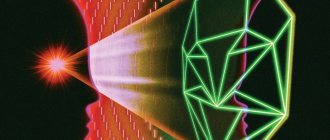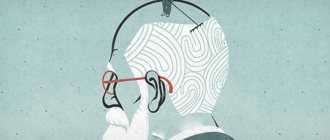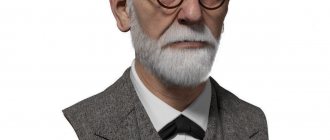Definition
Psychoanalysis according to Sigmund Freud is a very important part in psychology, its foundation. In his works there are many definitions of psychoanalysis - it is a means for self-knowledge and research, a method of awareness of the unconscious, a tool for spiritual and moral research, as well as a technique for treating various mental illnesses and getting rid of experiences.
It was precisely the multiplicity of definitions of Freud's psychoanalysis that made it possible to subsequently create various interpretations of it. Since the theory and practice of psychoanalysis were continued, developed and criticized by a large number of researchers, almost each of them gave their own interpretation and definition of psychoanalysis.
For example, Dr. A. Adler, Freud’s colleague and head of the Institute of Psychoanalysis, created his own version of it - individual psychology. He believed that psychoanalysis should study not the causes, but the goals of neuroses. Namely, an inferiority complex and the desire for socialization and power that arise in the process of raising children and continue to develop with age.
Another student of Freud, C. Jung, proceeded from the psychoanalytic concept of the unconscious of the individual. But he developed it and created analytical psychology with the doctrine of the collective unconscious. And psychoanalysis, in his opinion, is a way to identify common key points (archetypal), hidden in the past not of an individual person, but of peoples and even humanity as a whole.
Neo-Freudianism arose in 1920-1930. Its representatives K. Horney, E. Fromm abandoned the significant influence of libido on the formation of personality and its pathology in classical psychoanalysis. In their opinion, the main task of psychoanalysts is to identify the social and cultural factors that most influence a person from childhood.
The continuators of classical psychoanalysis were specialists in the field of ego psychology. They focused their attention on transference neurosis and considered psychoanalysis a method for identifying the maximum number of such phenomena in a person’s life, starting from early childhood.
After 1950, the direction of psychosomatic medicine arose. Doctors of this direction considered psychoanalysis a method of treating various somatic diseases, even those of organic origin. Using psychoanalytic techniques, they treated organ neurosis.
In 1960, the scientist J. Lacan transformed classical psychoanalysis into structural one. Unlike the first, he created a new topological model of the psyche, in which he identified not the unconscious, preconscious and consciousness, but the symbolic, imaginary and real.
After 1970, A. Lorenzer defined the foundations of psychoanalytic hermeneutics. He considered consciousness to be no less important in the formation of personality than the unconscious. It is in consciousness that a combination of collective and individual norms takes shape, forming a symbolic life project.
Psychoanalysis by Sigmund Freud
Human behavior is, first of all, regulated by his consciousness. Freud found out that behind the sign of consciousness there is a certain layer of it, unconscious by the individual, but prompting him to many lusts and inclinations. Due to the specific nature of his activity, he was a practicing doctor and came across a whole layer of unconscious motives.
In many cases, they became the source of nervous and mental illnesses. The discovery contributed to the search for means that could help the patient get rid of the confrontation between the obvious and hidden in the depths of consciousness. The result was Sigmund Freud's psychoanalysis, a means of spiritual liberation.
Without stopping at the treatment of neuropathic disorders, Freud, striving for the maximum restoration of the mental health of patients, developed the theoretical principles of psychoanalysis and introduced them into practice.
Due to its uniqueness, the proposed technology for restoring mental health has gained widespread fame and popularity over time. In the classical version, psychoanalysis announced the birth of a completely new system of psychology, and this event is often called a psychoanalytic revolution.
go to top
Essence and basic principles
Austrian neurologist Sigmund Freud is the recognized founder of the theory of psychoanalysis and the treatment method of the same name. In 1880, he, together with Dr. Joseph Breuer, observed the effect of hypnosis on hysterical attacks in women. During hypnotic sessions, patients recalled, reacted very emotionally and experienced traumatic events in their lives.
Breuer called this state catharsis. After being brought out of the trance, they had absolutely no memory of what had happened. However, after the session there was complete relief from all symptoms of hysteria and neurosis.
This led Freud to understand that the causes of various mental illnesses and manifestations lie in that part of the personality that is not consciously recognized by the person, i.e. in the unconscious. He began to look for ways to extract this information in order for the patient to consciously experience these events.
He had to work with many patients with hysterical and neurotic disorders of various origins, including syphilitic and organic. In conversations with them, he used a study of the dreams and fantasies of patients, their slips and slips.
So, initially using psychoanalysis as a method of treating patients, Freud, on its basis, by the end of 1890, formed the theory of psychoanalysis. And later he supplemented it with “The Interpretation of Dreams.” Freud later described personality structure and a theory of human behavior.
Psychoanalysis in psychology is a number of basic postulates:
- The structure of the human psyche is similar to an iceberg, where the tip is consciousness, and the huge underwater part is the unconscious. Between them there is a small layer in the form of preconsciousness, which serves for temporary storage of information.
- The unconscious is filled with irrational drives and desires, it is devoid of morality and symbolic. It stores all unresolved conflicts, traumatic events, and all kinds of fears that have been repressed from consciousness. They are not consciously realized by a person, but completely determine his experience, relationships with others and behavior.
- Everything that is socially unacceptable - sexual desires, drives, pleasures - is repressed in the process of human development and life into the area of the unconscious. And from there it continues to influence the manifestations of this person. If a strong contradiction begins between the content of the unconscious and consciousness, then a conflict arises. It can manifest itself in the form of neuroses, hysteria, and depression.
- An attempt to become aware of any elements of the unconscious encounters persistent resistance with the help of various mental mechanisms - projection, denial, sublimation, regression and others. This is how our brain is protected from the influx of very powerful repressed drives. Therefore, contact with a psychoanalyst is necessary for this purpose.
- If defense mechanisms cope with the flows of the unconscious, a person can be creatively gifted in any field of science, culture or art. If there are not enough mechanisms, or this flow is too powerful, various diseases arise - neuroses, depression, anxiety, hysteria.
- The human psyche is controlled by two types of energy. The first is sexual, creative energy - libido. The second is destructive, destructive. Unlike animals, whose behavior is subject to instincts, man is controlled by his past experience, contained in the unconscious. And the tension that arises during conflicts can be reduced by a person using the direct direction of energy (sexual or destructive actions), or through sublimation.
- Genetic approach. All desires, drives and unresolved conflicts in childhood affect all manifestations of the adult personality. Depending on the stage of development (up to 2 years oral, 2-4 fecal and from 4-5 years genital) all unsatisfied desires receive different manifestations in adulthood. They also require awareness and permission to get rid of interfering habits and neuroses.
There are many psychoanalytic methods of influence, but they can be combined into several stages. First, the doctor must obtain as much information as possible about the patient's unconscious. For this purpose, the method of free associations, interpretation of dreams and various erroneous words and actions are used. In some cases, hypnotic influence is also used.
Next, the doctor must identify, overcome and show the patient his methods of psychological defense. And in the finale, he shows the patient significant conflicts, suppressed desires, and allows him to survive traumatic events.
The main stages in the development of the science of mental development of personality
Psychology today has applied significance as a field of medicine, philosophy, pedagogy, and other sciences. Psychoanalytic theories of development are of particular importance in working with the individual. Each such theory has its own nuances in explaining the current personality and was developed by one or another specialist. But the history of this work proceeded in several stages. The most famous person whose name is associated with the study of mental characteristics of the individual is Sigmund Freud. But studies of this facet of the human individual, akin to the concept of psychoanalysis proposed by Freud, developed before the 19th century. The future world-famous psychologist, neurologist and psychoanalyst himself interned at the Salpêtrière clinic in Paris with neurologist and syphilologist Jean-Martin Charcot, who deeply studied the neuropsychiatric disorder paresis, as a consequence of syphilis. In 1985, the work of Sigmund Freud and Joseph Breuer, “Studies on Hysteria,” was published, which substantiates the origin of hysteria on repressed memories of any unpleasant situations for the patient, most often based on sexual associations. This view of one of the mental characteristics of the individual led to the fact that the majority of the scientific elite turned away from Freud, who exposed the novice psychoanalyst as an ordinary charlatan.
During the same period, the future psychoanalyst tries to formulate and build into a logical chain a neurophysiological theory of unconscious mental mechanisms. This work remained unfinished, and the world learned about it only after the death of the scientist. Then Freud became interested in the symbolism of dreams, the result of these thoughts was the hypothesis that the unconscious, on which the plot of dreams is based, is a “primary process”, since it has a concentrated and symbolic content. The “secondary process,” on the contrary, is based on logical, conscious content. This hypothesis became the basis of the monograph The Interpretation of Dreams, published by Freud in 1900. A feature of this psychologist’s work, which was developed in subsequent work, was Chapter 7. This describes an early “topographic model” - due to social sexual prohibitions, unacceptable sexual desires are squeezed into the “unconscious” system, which becomes the basis of individual anxiety.
In our country, a widespread passion for psychoanalysis occurred in the 20s of the 20th century. Then the State Psychoanalytic Institute was opened in Moscow. But gradually psychoanalysis ceases to be a branch of science and is subject to persecution. Only at the end of the century this area of human research regained life in Russian psychology and psychiatry. Currently, the areas of psychoanalysis have become an integral part of medical practice, and the theory itself is constantly supplemented by new theoretical developments. Psychologists unite around the world for high-quality scientific research into the human psyche. for example, the International Psychoanalytic Association, which has about 12,000 members, deals with the problems of psychoanalysis. Modern psychology operates with more than one school of psychoanalysis, because Freud’s students and followers organized their own schools and areas of study in this area of science, for example, Jung, Fromm, Adler.
Psychological theories and schools
Psychoanalysis in psychology is the most important element of its theory and practice. That is why Sigmund Freud had many not only admirers and successors, but also critics.
Each of them partially accepted the postulates of psychoanalysis, but disagreed with some of them, making their own amendments and creating new theories. This is how numerous psychological schools arose, still owing their appearance to classical psychoanalysis.
Analytical, depth psychology
The C. Jung Institute and the Society of Analytical Psychology were founded in 1948 in Zurich. Carl Jung worked with Freud and partially accepted the tenets of psychoanalysis until 1911. Then he discovered that there is not only an individual unconscious, but also a collective one.
Psychoanalysis was introduced into psychology by S. Freud
It refers to the structure of the psyche inherited by many generations over hundreds of thousands of years. It was she who, with the help of archetypes, determined the development of people of all times and cultures. Archetypes are universal human symbols, understood intuitively.
Jung also identified such parts of the unconscious as individual, family, group, national and collective. That is, the development potential of a person at the moment of his birth is already practically determined by previous generations.
Ego psychology
Its creators were Anna Freud (daughter of Sigmund Freud) and Melanie Klein. Anna studied mainly the I (ego, preconscious) and the mechanisms of its influence on the IT (unconscious). She developed a theory of defense mechanisms that the ego uses to repress conflicts and drives into the unconscious.
Anna Freud also worked with children all her life and created child psychoanalysis. The method of classical psychoanalysis was reworked by her and adapted for working with children, including in playful forms.
Object relations theories (British school of psychoanalysis)
Representatives of this direction have expressed the theory that the structures of the I and the Id are already present in the baby from birth. It is the relationship between the baby and significant adults that determines his further personal development.
Scientists agreed with the determining influence of these relationships at different stages of development - oral, anal and genital on the subsequent Oedipus complex and Electra complex. Even the objects surrounding the baby play an important role. In subsequent adult life, a person transfers scenarios of relationships with significant adults from childhood, adding various objects to this.
Structural psychoanalysis by J. Lacan
Lacan began his psychoanalytic research in 1950. He suggested that the unconscious has its own structure and it resembles language. He also tried to discover connections between being, cognition, consciousness and the unconscious.
In his opinion, the id is real, the ego is imaginary, and the super-ego is the unconscious symbolic. And in ordinary life it is the super-ego that opposes the imaginary. Art and its images are a product of the super-ego; they constitute a separate world. However, all these symbols confirm the existence of It.
Self-psychology (H. Kohut)
It arose in the 1960-1970s in the USA as a continuation of classical psychoanalysis, but with an emphasis on a person’s experience of self.
Kohut worked with patients who had narcissistic disorders and noticed that they had specific transference mechanisms of different types. He identified idealizing, mirror and twin self-transference. He proposed limiting the psychoanalytic technique to introspection; I consider other methods not empirically confirmed.
Interpersonal psychoanalysis (G.S. Sullivan, Clara Thompson)
Since the late 1920s, Sullivan worked primarily with patients with a schizoid personality type or disorder. He realized that the very concept of personality is conditional and unprovable.
And therefore he developed the theory of interpersonal psychoanalysis, which proposed interpersonal relationships as the main object of study. He supplemented it with special psychotechnics. They allow you to identify your repressed and suppressed desires and conflicts through interaction and behavior with other people.
Intersubjective approach (R. Stolorow)
It was developed in the 70s of the last century based on Kohut’s Self-Psychology. Its emphasis is on improving the affective interaction between doctor and patient as two subjective worlds. To this end, the mechanism of transfer and resistance between the two selves that form the intersubjective field is being actively studied.
Indications for use
Psychoanalysis in psychology is the most “medical” part of it, a method of treating certain diseases and correcting existing personal problems.
It is recommended to be used in the following situations:
- anxiety states,
- obsessive words, actions, thoughts,
- panic attacks,
- neuroses of various manifestations and origins,
- various addictions,
- phobias,
- depressive states,
- psychosomatic diseases,
- conflict, frequent stress,
- family problems,
- personal and sexual problems.
Psychoanalysis as a branch of psychology
The definition of the characteristics of the human psyche proposed by Freud has become widespread in psychology. Today, many modern methods of psychotherapeutic correction are built on this theory. Jung's analytical psychoanalysis and Adler's individual psychoanalysis are one of the main “tools” for identifying internal conflicts that are sources of pathological perception.
The theories of the above-mentioned scientists are based on the research of Sigmund Freud. The main difference between these techniques is the limited importance of sexual motives. Thanks to Freud's followers, the unconscious part of the personality received new characteristics. According to Adler, the manifestation of lust for power is compensation for an inferiority complex. Jung's research was based on the study of the collective unconscious. According to the scientist, the unconscious part of the individual’s psyche is based on hereditary factors. According to Freud himself, the unconscious level is filled with phenomena that were pushed out of the conscious part of the psyche.
Advantages and disadvantages
As a theory and practical technique, psychoanalysis has a number of advantages. as well as shortcomings.
| Advantages | Flaws |
| The unconscious becomes the center of mental life | You can study the unconscious only by extracting information from there into consciousness, and in this case many distortions arise |
| You can help the patient “remember” many facts from the past in order to experience events and heal | Sometimes traumatic events cannot be processed and acted out, and then it is possible that either the problems or illness will persist, or even the condition will worsen. |
| Methods of psychoanalysis have been developed for practical work with patients | The interpretation of free associations, dreams and slips of the tongue is very subjective and is highly dependent on the experience, culture and moral character of the doctor himself. |
| The sexual sphere has become studied by psychologists and its influence on human development and life is very great | Sometimes the importance of libido and complexes is exaggerated by a doctor who denies the influence of upbringing, environment and environment |
| Therapy not only allows you to get rid of diseases or problems, it simply expands the boundaries of a person’s consciousness into areas previously unknown to him | Psychoanalytic therapy is very long-term, often expensive and does not guarantee improvement or cure. |
Methods
Psychoanalysis in psychology is not only a theory, but also a practical method of working with patients. It has a clear structure and direction of research, which can take many months and even years.
- Free association method. During sessions, in the early stages of work, the psychoanalyst suggests telling the patient absolutely everything that comes to mind. All thoughts, no matter how insignificant, are obscene or frivolous at first glance. They help to study the patient’s unconscious and identify conflicts and complexes.
- Interpretation of dreams. Repressed desires located in the unconscious strive to penetrate consciousness. But, since in the waking state they encounter resistance in the form of defense mechanisms, this process occurs much more simply during sleep. In the form of symbolic meanings, often in a distorted, condensed or displaced form, they are transformed into visual images. And immediately after waking up, before the images have time to pass into the preconscious, many people are able to describe their dreams in detail. From them, a psychoanalyst can glean a lot of useful information about the work of the unconscious and the conflicts and drives of an individual contained in it. The main thing is to correctly interpret what you see.
- Identifying erroneous words (spoken or written) or actions. The influence of the unconscious on human behavior is undeniable, but there is nothing random about it. And this can be seen most clearly in the example of supposedly “erroneous” actions or words. The doctor examines slips of the tongue, typos, and accidentally repeated actions. In fact, these words or actions are exactly what the person really wants. It’s just that they are usually blocked by consciousness, not counting such failures. For example, a person promises and wants to attend some important meeting, but at the same time repeatedly “forgets” about it, or “oversakes” or is late. This is what eloquently suggests that he doesn’t really want to meet. And his behavior simply obeys in this case.
- Identification of repression, transference, denial, resistance, rationalization, regression and other defense mechanisms. There are about 30 of them in total. Since the content of the unconscious is not subject to social norms and educational guidelines, with the help of protective mechanisms the human psyche keeps his behavior and thoughts within the framework of socially approved rules and decency. The patient can transfer his desires to another person (including the doctor), can replace them with others, deny them, try to rationally explain them, refuse them, and even sublimate them in another direction. Moreover, during the study of his free associations, dreams or slips of the tongue, real suppressed desires can still be identified.
- At the last stage of psychoanalysis, identified conflicts and traumatic events are worked through, interpreted, and experienced again. Once the patient fully understands and accepts these events, the conflict can be resolved. As a result, disturbing symptoms, anxiety, depression, neuroses disappear, and the course of psychosomatic diseases is mitigated.
Thus, psychoanalysis, as a theory and methodology, has made an invaluable contribution to psychology and medicine, revealing new horizons of human personality. He gained many followers and schools that continued his ideas. And in practice it is used by many psychologists and doctors.
Author: Natalya Kalegova
Self-defense
Freud's psychoanalytic theory of personality describes defense mechanisms by which the human psyche copes with certain potential problems.
- Substitution - energy and emotions are redirected to a less dangerous object.
- Reactive formation is an experience that, in the opinion of the individual, is unworthy of him, is suppressed, and then replaced by the exact opposite feeling.
- Compensation is an unconscious attempt to cope with real or imagined shortcomings and can be both social and antisocial in nature.
- Repression is the forced transfer into the sphere of the unconscious of those subconscious drives and experiences that pose a threat to self-consciousness.
- Denial is the unwillingness to come to terms with existing reality.
- Projection is the transfer to other people of one’s own experiences and qualities that are unacceptable both by society and by the person himself.
- Sublimation - changing unacceptable behavior and goals to socially acceptable ones.
- Rationalization is, in other words, self-justification. A person tries to rationally explain actions committed under the influence of the unconscious.
- Regression is a return to early forms of behavior, as they sometimes say a person relapses into childhood. This method of defense is mainly used by immature, infantile people, but in some situations it can also be used by completely normal adults.
But not only Freud’s psychoanalytic theory of development contains a description of the defense mechanisms of the psyche. Other psychoanalysts, developing Freud's theory or developing their own projects, expanded the list of self-defense of the individual's psyche, which currently includes about 30 items.











